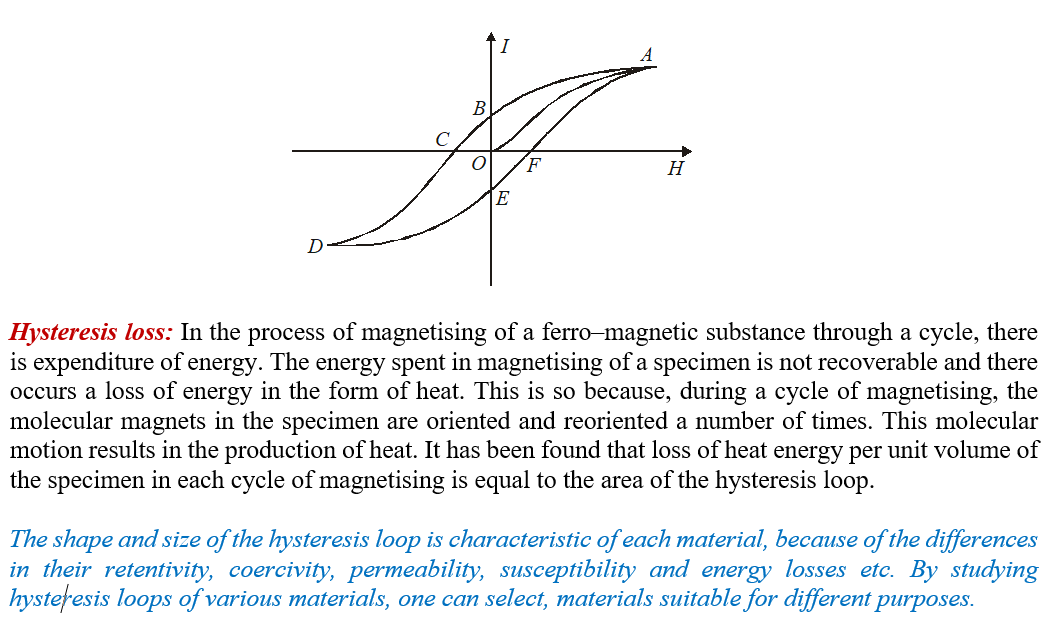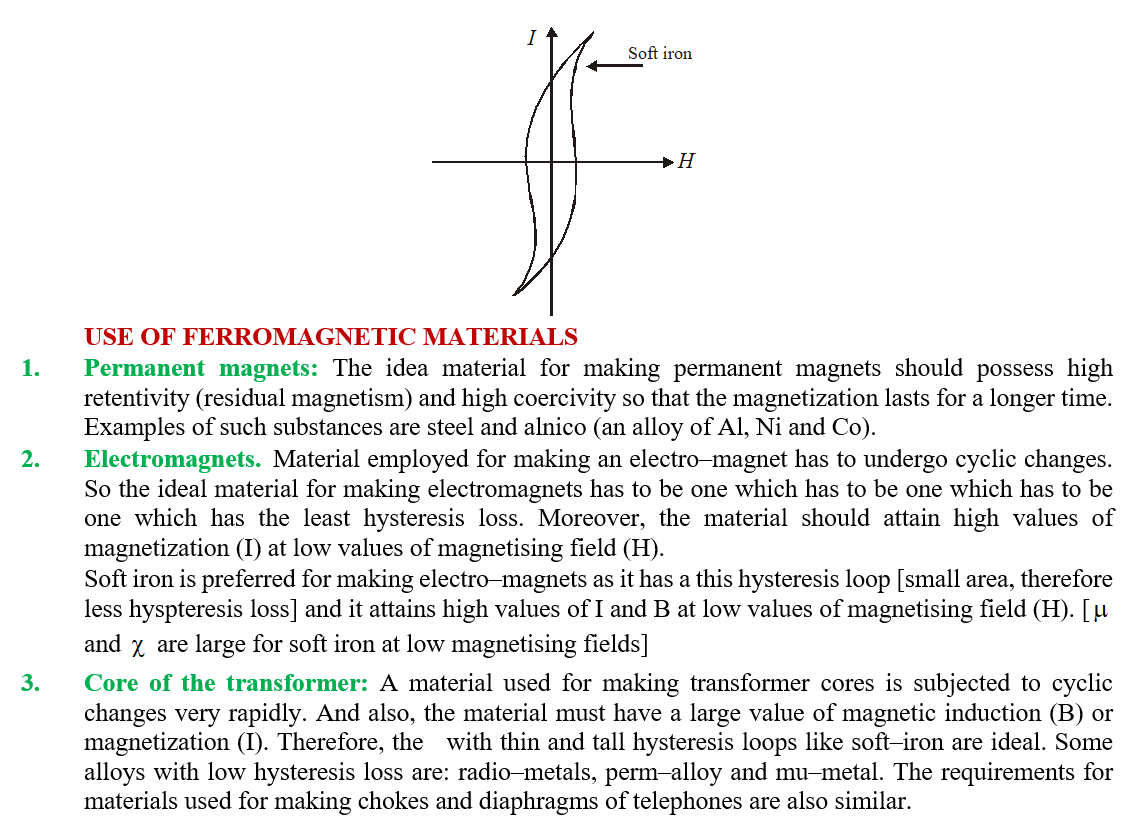Video Lecture
Theory For Making Notes






CLASSIFICATION BETWEEN DIA, PARA AND FERRO–MAGNETIC MATERIALS
| Diamagnetic | Paramagnetic | Ferromagnetic |
1. | Such substances are repelled weakly by a magnet | Such substances are weakly attracted by a magnet | Such substances are strongly attracted by a magnet |
2. | Individual atoms or molecules have no net magnetic moment in the absence of H–field | Individual atoms or molecules have non–zero magnetic moments in the absence of H–field | Individual atoms or molecules have non–zero magnetic moments with ‘atomic magnets’ organized into domains in the absence of H–field. |
3. | When placed in external magnetic field, then within the material, the resultant field is reduced and field lines are repelled by such materials | When placed in uniform external magnetic field, then within the material resultant field is enhanced and field lines concentrate. | When placed in external magnetic field, then within the material, field is strongly enhanced and filed lines are highly concentrated. |
4. | When placed in a non–uniform external magnetic field, the substance tends to move from high to low field region | When placed in non–uniform external magnetic field, the para–magnetic substance tends to move from low to high field region | When placed in non–uniform external magnetic field, the substance has strong tendency to move from low to high field region. |
5. | is just less than one | is just greater than one | (~ 680 for iron) |
6. | Susceptibility of dia-magnetic substance is negative | Susceptibility of paramagnetic substances has small positive value . | Susceptibility for ferro–magnetic substances has large positive values for iron). |
7. | Susceptibility does not change with temperature and diamagnetics do not obey Curie law | varies inversely with the increase of temperature and paramagnetic substances obey Curie law. | Susceptibility decreases with the increase in temperature and beyond Curie temperature, ferro–magnetic substances behave like paramagnetic substances. |




Practice Questions (Basic Level)
1.
Magnets cannot be made from which of the following substances
(a) Iron
(b) Nickel
(c) Copper
(d) All of the above
Ans (c)
2.
The magnetic moment of atomic neon is
(a) Zero
(b) \mu B/2
(c) \mu B
(d) 3\mu B/2
Ans (a)
3.
Which of the following is most suitable for the core of electromagnets (a) Soft iron
(b) Steel
(c) Copper-nickel alloy
(d) Air
Ans (a)
4.
Substances in which the magnetic moment of a single atom is not zero, is known as
(a) Diamagnetism
(b) Ferromagnetism
(c) Paramagnetism
(d) Ferrimagnetism
Ans (c)
5.
If a diamagnetic solution is poured into a U-tube and one arm of this U-tube placed between the poles of a strong magnet with the meniscus in a line with the field, then the level of the solution will
(a) Rise
(b) Fall
(c) Oscillate slowly
(d) Remain as such
Ans (b)
6.
The magnetic susceptibility does not depend upon the temperature in
(a) Ferrite substances
(b) Ferromagnetic substances
(c) Diamagnetic substances
(d) Paramagnetic substances
Ans (c)
7.
The magnetic susceptibility is negative for
(a) Paramagnetic materials
(b) Diamagnetic materials
(c) Ferromagnetic materials
(d) Paramagnetic and ferromagnetic materials
Ans (b)
8.
Curie temperature is the temperature above which
(a) A paramagnetic material becomes ferromagnetic
(b) A ferromagnetic material becomes paramagnetic
(c) A paramagnetic material becomes diamagnetic
(d) A ferromagnetic material becomes diamagnetic
Ans (b)
9.
A frog can be deviated in a magnetic field produced by a current in a vertical solenoid placed below the frog. This is possible because the body of the frog behaves as
(a) Paramagnetic
(b) Diamagnetic
(c) Ferromagnetic
(d) Antiferromagnetic
Ans (b)
10.
Which one of the following is a non-magnetic substance
(a) Iron
(b) Nickel
(c) Cobalt
(d) Brass
Ans (d)
11.
Liquid oxygen remains suspended between two pole faces of a magnet because it is
(a) Diamagnetic
(b) Paramagnetic
(c) Ferromagnetic
(d) Antiferromagnetic
Ans (b)
12.
For an isotropic medium B, m, H and M are related as (where B,\,\,{{\mu }_{0}},\,\,H and M have their usual meaning in the context of magnetic material
(a) (B-M)={{\mu }_{0}}H
(b) M={{\mu }_{0}}(H+M)
(c) H={{\mu }_{0}}(H+M)
(d) B={{\mu }_{o}}(H+M)
Ans (d)

Practice Questions (JEE Main Level)
Q.1
The magnetic H-field at the center of a circular conductor is of radius ‘a’ and number of turns ‘N’ carrying current I is
(a) H=\frac{{NI}}{{2a}}
(b) H=\frac{{{{\mu }_{0}}NI}}{{2a}}
(c) H=\frac{{NI}}{a}
(d) H=\frac{{NI}}{{2\pi a}}
Ans : (a)
Q.2
The magnetic H-field due to a long, straight conductor carrying current I at a distance d is
(a) \frac{{{{\mu }_{0}}}}{{4\pi }}\frac{I}{d}
(b) \frac{{{{\mu }_{0}}}}{{2\pi }}\frac{I}{d}
(c) \frac{I}{{2\pi d}}
(d) \frac{I}{{2\pi {{d}^{2}}}}
Ans : (c)
3.
The material of permanent magnet has
(a) High retentivity, low coercivity
(b) Low retentivity, high coercivity
(c) Low retentivity, low coercivity
(d) High retentivity, high coercivity
Ans (d)
4.
The magnetic susceptibility is
(a) \chi =\frac{I}{H}
(b) \chi =\frac{B}{H}
(c) \chi =\frac{M}{V}
(d) \chi =\frac{M}{H}
Ans (a)
5.
The relative permeability is represented by mr and the susceptibility is denoted by c for a magnetic substance. Then for a paramagnetic substance
(a) μ< 1, χ< 0
(b) μ< 1, χ> 0
(c) μ> 1, χ< 0
(d) μ> 1, χ> 0
Ans (d)
6.
Relative permeability of iron is 5500, then its magnetic susceptibility will be
(a) 5500 x 107
(b) 5500 x 10–7
(c) 5501
(d) 5499
Ans (d)
7.
If the angular momentum of an electron is \overrightarrow{{J\,}} then the magnitude of the magnetic moment will be
(a) \frac{{eJ}}{{2m}}
(b) \frac{{eJ}}{{m}}
(c) eJ 2m
(d) \frac{{2m}}{{eJ}}
Ans (a)
8.
Which of the following statements is incorrect about hysteresis
(a) This effect is common to all ferromagnetic substances
(b) The hysteresis loop area is proportional to the thermal energy developed per unit volume of the material
(c) The hysteresis loop area is independent of the thermal energy developed per unit volume of the material
(d) The shape of the hysteresis loop is characteristic of the material
Ans (a)
9.
Curies law can be written as
(a) \chi \propto (T-{{T}_{c}})
(b) \chi \propto \frac{1}{{T-{{T}_{c}}}}
(c) \chi \propto \frac{1}{T}
(d) \chi \propto T
Ans (c)
10.
If the magnetic dipole moment of an atom of diamagnetic material, paramagnetic material and ferromagnetic material denoted by {{\mu }_{d}},\,{{\mu }_{p}},\,{{\mu }_{f}}respectively then
(a) {{\mu }_{d}}\ne \text{ 0 and }{{\mu }_{f}}\ne \text{ 0}
(b) {{\mu }_{p}}=\text{ 0 and }{{\mu }_{f}}\ne \text{ 0}
(c) {{\mu }_{d}}=\text{ 0 and }{{\mu }_{p}}\ne \text{ 0}
(d) {{\mu }_{d}}\ne \text{ 0 and }{{\mu }_{p}}=\text{ 0}
Ans (c)
11.
When a ferromagnetic material is heated to temperature above its Curie temperature, the material
(a) Is permanently magnetized
(b) Remains ferromagnetic
(c) Behaves like a diamagnetic material
(d) Behaves like a paramagnetic material
Ans (d)
Practice Questions (JEE Advance Level)
Lorem ipsum dolor sit amet, consectetur adipiscing elit. Ut elit tellus, luctus nec ullamcorper mattis, pulvinar dapibus leo.
